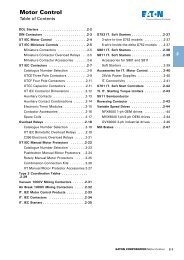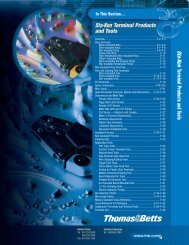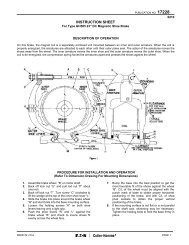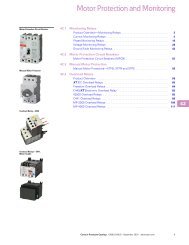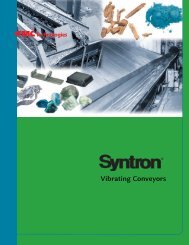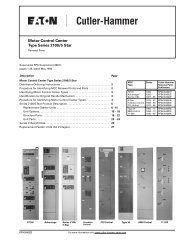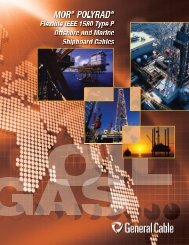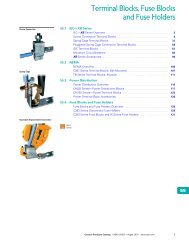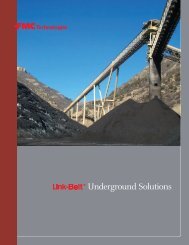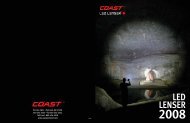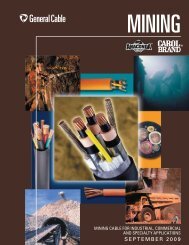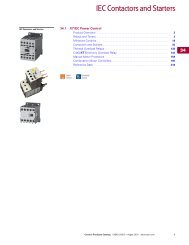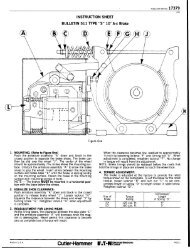Syntron® Electromagnetic Feeders - FMC Technologies
Syntron® Electromagnetic Feeders - FMC Technologies
Syntron® Electromagnetic Feeders - FMC Technologies
Create successful ePaper yourself
Turn your PDF publications into a flip-book with our unique Google optimized e-Paper software.
Recommended Hopper Design and Feeder SelectionRefer to Figure 2.1. Rear wall angle steep enough to permit material flow (60˚ ± 5˚).2. Front wall angle just enough to permit material flow (55˚ ±5˚).3. The throat dimension “T” for random size material should be aminimum of 2 times the largest particle of material. For particlesthat are nearly the same size (near size), “T” should be a minimumof 4 times the largest particle size to prevent blockage at the throatopening. In all cases, the arc “A” should exceed 2 1/2 times thelargest particle size.4. Gate opening “H” must be a minimum of 2 times the largestparticle of material and should increase proportionally for thedesired capacity. The most economical feeder is selected when thethroat dimension “T” is equal to or slightly larger than H/2. If “T” isgreater than “H” the flow pattern of the material is disturbed, resultingin non-uniform flow.5. When adjustable gates are used, the gate must be parallel to thehopper’s front wall and must be as close to the front wall as possible.The separation must not exceed 2 inches. The gate should act as anadjustable front wall. Leveling blades and down stream gates mustnot be used. Horizontal cut off gates should be used to performfeeder maintenance and must not be used to regulate flow.6. The inside width of the opening “D” (between stationary skirtboards)should allow for a 1-inch clearance between the feeder trough andskirt boards and should be a minimum of 2 1/2 times the largestparticle size. For near size material the width of “D” should be aminimum of 4 times the largest particle size.7. The minimum length of the feeder is determined by projecting theangle of repose for the specific material from the gate point to thefeeder pan and adding approximately 6 inches.8. The feeder must not contact any adjacent structure but must befree to vibrate. Allowance must be made for a decrease in feederelevation of approximately 2 inches, due to static material load. Inaddition, 1 inch minimum clearance at sides and 1 1/2 inches atbottom and back must be maintained in both loaded and unloadedconditions.9. The skirts must taper in the direction of flow (diverge fromconveying surface) to prevent material from jamming and causingadditional problems such as spillage and build-up. Skirts must runparallel to trough sides and must be reinforced to resist bulgingoutward against trough.Figure 2. Ideal Hopper IllustrationFor more information about hopper design,please request our free book or CD ROM,“Working with Hoppers.” Or, visit ourwebsite, call our Application Specialists at(662) 869-5711 or (800) 356-4899 or emailus at mhsol.info@fmcti.com.<strong>FMC</strong> <strong>Technologies</strong> offers free review and advice onyour hopper and Syntron ® feeder installation andisolation. Just send us your layout drawings.Material Handling Solutions31www.fmctechnologies.com/materialhandling



